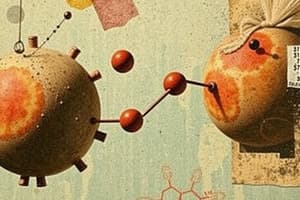Podcast
Questions and Answers
Why do elements in Group 1A, 2A, and 3A tend to form cations?
Why do elements in Group 1A, 2A, and 3A tend to form cations?
- They lose electrons to achieve a stable outer electron configuration. (correct)
- They have a naturally stable outer electron configuration.
- They gain electrons to achieve a stable outer electron configuration.
- They share electrons to achieve a stable outer electron configuration.
Which statement accurately describes the change in atomic size across a period (left to right) on the periodic table?
Which statement accurately describes the change in atomic size across a period (left to right) on the periodic table?
- Atomic size increases because of enhanced electron-electron repulsion.
- Atomic size decreases because the increasing nuclear charge pulls electrons closer to the nucleus. (correct)
- Atomic size remains constant because the number of protons and electrons are equal.
- Atomic size increases due to the increasing number of energy levels.
How does metallic property change as you move down a group in the periodic table, and why?
How does metallic property change as you move down a group in the periodic table, and why?
- Decreases, because the ionization energy decreases significantly.
- Increases, because the valence electrons are farther from the nucleus. (correct)
- Decreases, because the number of valence electrons increases.
- Remains constant, because the nuclear charge is balanced by the increasing number of electrons.
What happens to the size of an atom when it forms a cation, and why?
What happens to the size of an atom when it forms a cation, and why?
Which of the following statements correctly describes the trend in ionization energy across a period (from left to right) on the periodic table?
Which of the following statements correctly describes the trend in ionization energy across a period (from left to right) on the periodic table?
How does electron affinity change as you move from left to right across a period in the periodic table, and what is the underlying reason for this trend?
How does electron affinity change as you move from left to right across a period in the periodic table, and what is the underlying reason for this trend?
Why do Group 8A elements (noble gases) have an electron affinity close to zero?
Why do Group 8A elements (noble gases) have an electron affinity close to zero?
Moving down a group, both atomic size and ionic size increase. What is the primary reason for the increase in atomic size?
Moving down a group, both atomic size and ionic size increase. What is the primary reason for the increase in atomic size?
How does the number of inner, fully-filled electron levels affect the electrostatic attraction between the nucleus and the valence electrons as you move down a group, and what is the consequence for atomic size?
How does the number of inner, fully-filled electron levels affect the electrostatic attraction between the nucleus and the valence electrons as you move down a group, and what is the consequence for atomic size?
For elements in Groups 5A to 7A, what causes them to gain electrons and form anions?
For elements in Groups 5A to 7A, what causes them to gain electrons and form anions?
Flashcards
Cations
Cations
Ions formed when atoms lose electrons; they have a positive charge.
Anions
Anions
Ions formed when atoms gain electrons; they have a negative charge.
Metallic Property
Metallic Property
The ability of an atom to donate electrons.
Atomic Size
Atomic Size
Signup and view all the flashcards
Ionization Energy
Ionization Energy
Signup and view all the flashcards
Electron Affinity
Electron Affinity
Signup and view all the flashcards
Cation Formation
Cation Formation
Signup and view all the flashcards
Anion Formation
Anion Formation
Signup and view all the flashcards
Atomic Size Trend
Atomic Size Trend
Signup and view all the flashcards
Ionization Energy Trend
Ionization Energy Trend
Signup and view all the flashcards
Study Notes
- Cations and anions form when one or more electrons are removed from or added to the highest occupied energy level.
- This process results in a stable outer configuration of electrons, typically with 8 valence electrons.
Formation of Cations
- Group 1A, 2A, and 3A elements achieve stability by losing electrons, forming positive ions termed cations.
- Group 1A elements have a valence of +1
- Group 2A elements exhibit a valence of +2
- Group 3A elements exhibit a valence of +3 as they lose one, two, and three electrons respectively, in the outer level.
Formation of Anions
- Group 5A to 7A elements attain stability when they gain electrons, forming negative ions called anions.
- Elements of the nitrogen group (5A) have a valence of -3
- Elements of the oxygen group (6A) have a valence of -2
- Group 7A halogens have a valence of -1 as their atoms gain 3, 2, and 1 electrons, respectively.
- Group 8A elements have eight valence electrons and zero valences, so they are unlikely to give up or take electrons.
Atomic Size
- Atomic size, or atomic radius, is the distance between the nucleus and its valence shell.
- Atomic size decreases from left to right across a period and increases down a group in the periodic table.
- Across a period, the increasing number of protons leads to a greater attraction between electrons and protons.
- The increasing nuclear charge pulls the electrons towards the nucleus, reducing the atomic size.
- Down a group, the number of energy levels increases, the atomic size increases.
- Inner-filled energy levels diminish electrostatic attraction between protons and electrons.
- This results in reduced effective nuclear charge and expansion of the atom.
Metallic Property
- Metallic property is the measure of an atom's ability to donate electrons.
- Metallic property decreases from left to right across a period and increases down a group which mirrors atomic size trends
- Smaller number of valence electrons and greater distance from the nucleus contribute to higher metallicity.
Ionic Size
- When a neutral atom gains or loses electrons, the nuclear charge remains constant, but electron-electron repulsion changes.
- In cation formation, the loss of electrons reduces electron-electron repulsions.
- In anion formation, the opposite occurs such that the electron-electron repulsions increase.
- Cations are smaller than their corresponding atoms while anions are bigger.
Ionization Energy
- Energy is required to remove electrons from an atom is termed ionization energy.
- Ionization energy increases from left to right across a period and decreases down a group.
- From top to bottom, the energy level and average distance of a valence electron from the nucleus increases, attraction weakens, and the electron is easier to remove.
- Across a period, the effective nuclear charge increases, strengthening the hold on electrons, and hence more energy is required to remove the electron.
Electron Affinity
- Electron affinity is the energy released when an electron is added to a neutral gaseous atom.
- The greater the electron affinity, the greater the attraction of an atom for an electron.
- Electron affinity increases from left to right within a period and decreases from top to bottom within a group.
- Elements on the left side of the periodic table exhibit a lower affinity for the incoming electrons whereas elements on the right side have a higher affinity.
- Group 7A elements possess the greatest electron affinity because they only need one electron to complete a stable configuration of 8 electrons.
- Noble gases have almost zero electron affinity because they are already stable and not expected to take electrons.
Studying That Suits You
Use AI to generate personalized quizzes and flashcards to suit your learning preferences.




